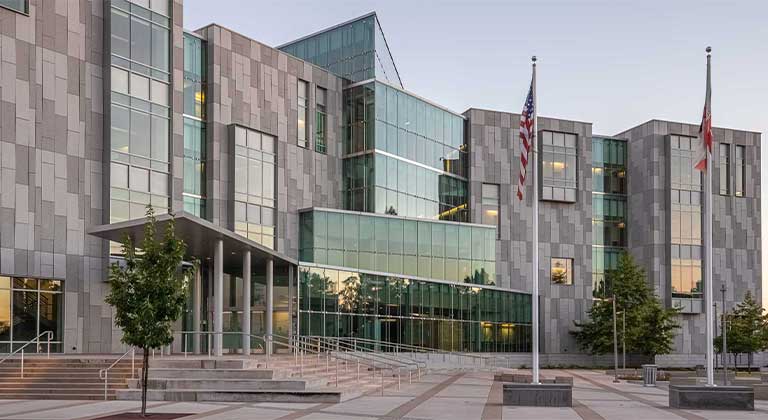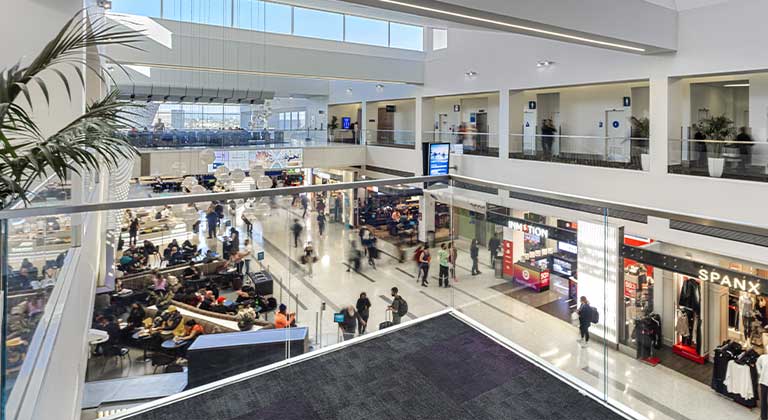Laminated glazing stands at the forefront of architectural innovation, offering a multifaceted solution that goes beyond conventional applications. This article explores the diverse capabilities of laminated glazing, emphasizing its role in supplying enhanced security, custom design flexibility, superior acoustics, and resilience against ballistics, burglary, and blast events.
What is Laminated Glass?
Laminated glass is comprised of layered glass made of two or more sheets of glass bonded together by a interlayer placed between them to resist fall-out should damage or breakage occur. The glass pieces can be made from any type of glass. The interlayer is usually made of some form of polyvinyl butyral (or PVB) material or sentry glass plus interlayer (SGP).
Compared with annealed glass or heat-strengthened glass, laminated glass is safer due to the way that it breaks. Annealed or heat strengthened glass shatters into many sharp pieces that are a potential safety hazard, while laminated glass remains intact even when broken. Because of these characteristics, Laminated glass meets building code safety glazing criteria, (The CPSC’s Safety Standard defines safety glass— as glass that is subject to human impact) and is further defined in test methods detailed in ANSI Z97.1-2015, the American National Standard for Safety Glazing Materials in Buildings-Safety Performance Specifications and Methods of Test to determine whether a particular glass is considered safety glazing or not. ANSI Z97.1-2015 is a voluntary standard that codifies both performance specifications and testing methods for safety glazing.
The laminated film in between helps keep laminated glass in place even after breaking. It also helps prevent the glass from breaking in the first place. For these reasons, it’s also commonly referred to as safety glass or shatterproof glass.
PVB vs. SGP
PVB (Poly Vinyl Butyral) is commonly used in insulated glass for doors and windows, interior partitions, and overhead glazing. SGP (SentryGlasPlus) developed by DuPont, is a more rigid material. The interlayer of SGP is 5x stronger and up to 100x stiffer than PVB. It is also superior in environments where the edges of glass are exposed to the exterior environment. SGP is most commonly used for exterior frameless balustrades, glass flooring, stairs, and applications where stiffness and rigidity are required.
Laminated Glazing Solutions for Enhanced Security in Glass Railing
Laminated Composition
Laminated glazing provides a robust barrier for glass railing systems. This combination not only enhances security without compromising transparency but also introduces a heightened level of resilience, creating an aesthetically pleasing and secure environment. The incorporation of SGP interlayer further reinforces the structural integrity of the laminate, providing an advanced solution for architects and designers seeking both safety and visual appeal in their projects.
Custom Design Integration
The design flexibility of laminated glazing allows architects and designers to create customized glass railing systems tailored to the project’s unique aesthetic vision. From transparent barriers to textured or colored variations, laminate glazing supports the realization of unique design aspirations.

Acoustic Performance: Meeting STC Requirements and Balancing Energy Efficiency
Noise Reduction Properties
Laminated glazing serves as a pivotal element in achieving acoustic comfort by effectively damping sound transmission. The interlayers within the laminate structure play a key role in absorbing and dispersing sound waves, making it an excellent choice for spaces where stringent noise reduction standards, as per Sound Transmission Class (STC) requirements, are crucial. This makes it particularly suitable for applications in offices, residential complexes, or hospitality settings where maintaining a quiet environment is essential.
Tailored Acoustic Solutions
Design teams can harness the versatility of laminate glazing to precisely address specific acoustic requirements while balancing energy efficiency considerations. By strategically adjusting the thickness and composition of the interlayers, the acoustic performance of the glazing system can be tailored to meet the nuanced needs of diverse environments. This customization ensures compliance with STC standards and allows for optimizing energy performance, providing a comprehensive solution for architects and designers.
Laminated Glazing Solutions for Ballistics, Burglary, and Blast Resistance
Customized Security Solutions
The customization options available for laminated glazing extend to security features, ensuring glazing solutions that align with the specific security needs of the project. This adaptability is reflected in Giroux Glass’s diverse portfolio, where security solutions are tailored for various sectors, including offices, civic spaces, healthcare facilities, and more.
Laminated Glazing Testing Standards
To achieve these ratings, laminated glazing undergoes rigorous testing following industry standards such as UL 752, EN 1063, ASTM F1233, ASTM F1642, and ISO 16933. These standards evaluate its performance in resisting ballistics, burglary attempts, and blast events.
The Power of Laminated Glazing Solutions
Laminated glazing is a versatile and indispensable component in modern architectural design. Its applications extend beyond mere transparency, offering enhanced security in glass railing systems, design flexibility, superior acoustics, and resilience against ballistics, burglary, and blast events. This versatility enables architects and designers to envision and realize holistic solutions that prioritize both form and function. Engaging early in the design process with glazing contractors, such as Giroux Glass, helps to identify performance criteria, maintain design aesthetics, and balance energy performance.
Giroux Glass recognizes the paramount importance of security across multiple sectors. Leveraging its technical expertise, the company excels in meeting stringent testing requirements for ballistic, burglar, and blast resistance.
Currently involved in a diverse range of projects, Giroux Glass strategically allocates its efforts to different sectors with a focus on ballistic glazing. Ongoing projects that include the installation of laminated glass for enhanced safety, acoustics and security can be broken down by market sector, as follows:
- Tenant improvement: 29%
- Office: 21%
- Healthcare: 17%
- Civic and culture: 8%
- Mixed-use: 8%
- Education: 4%
- Apartments, condominiums, and townhomes: 4%
- Sports and arenas: 4%
- Entertainment: 4%
This strategic distribution underscores Giroux Glass’s commitment to supplying specialized solutions tailored to the specific needs of each sector.
Contact us if you’re interested in delving deeper into security glazing options and discovering how Giroux Glass can assist you.


